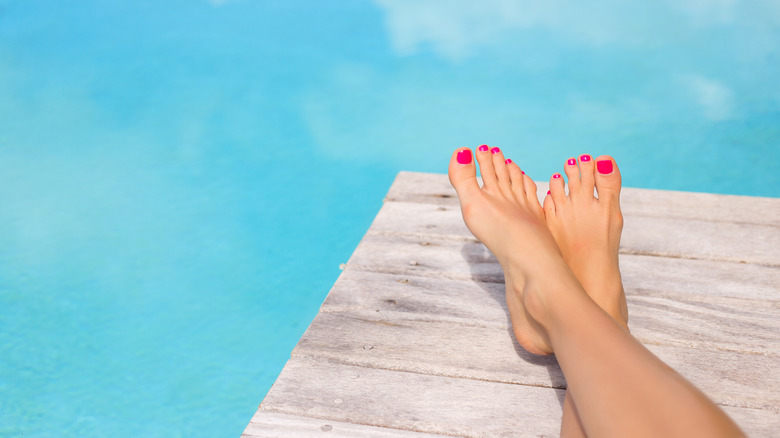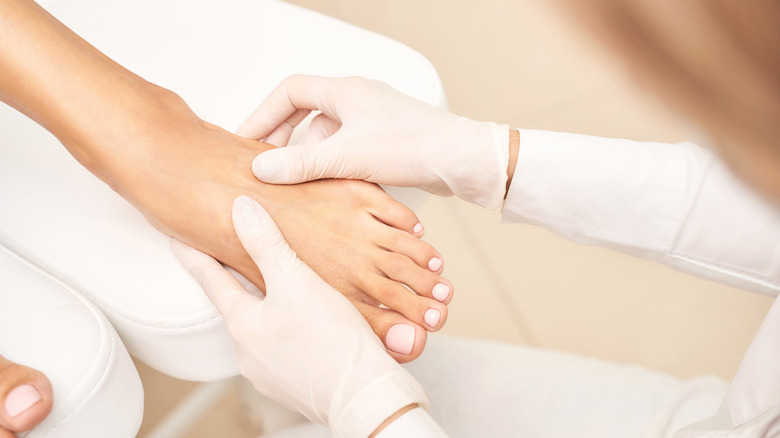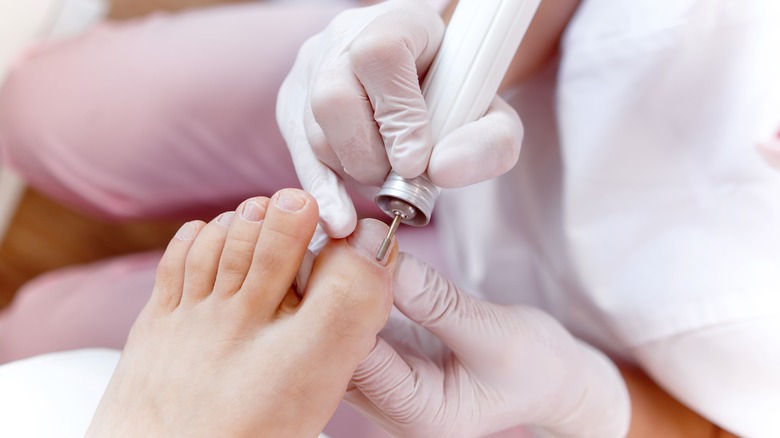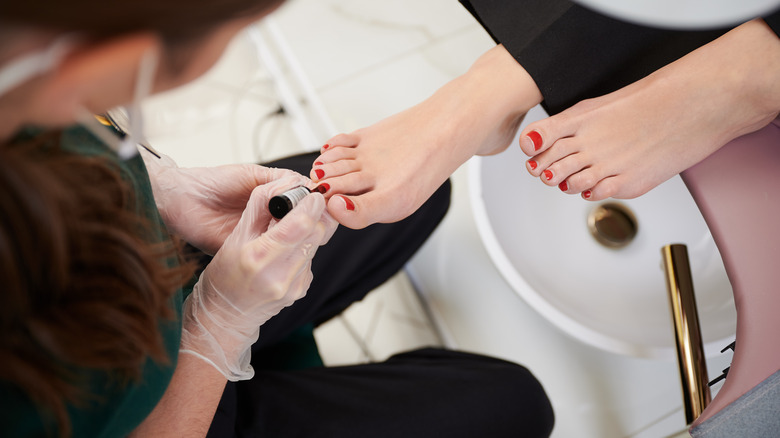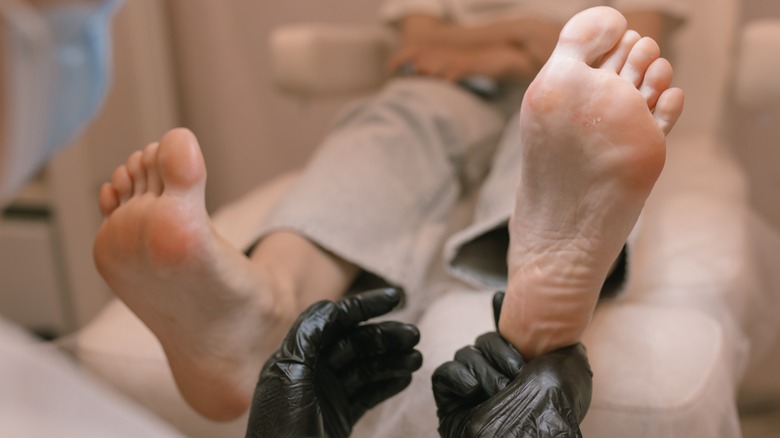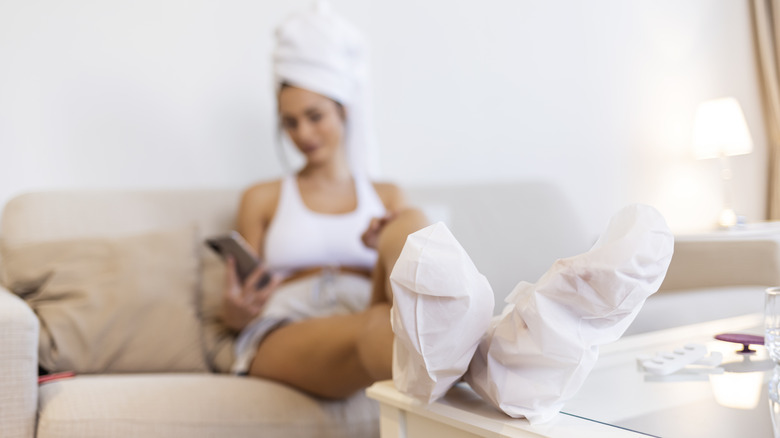Waterless Pedicures: What To Know Before Dipping Your Toes In The New Trend
Pedicures are our absolute favorite thing. They're relaxing, pamper our feet, and keep our soles buttery soft, and callus-free until our next session. But no matter how great your current traditional pedicure is, several steps in your feet routine are in need of intervention. One of these steps is the soak, which involves soaking your feet in the foot bath. Picture this: you're at the salon, and someone has just finished getting their feet scrubbed and polished in the foot spa or tub. An attendant or pedicurist cleans the tub with water and cleaning supplies, but some leftover debris from the previous person is still in the tub. Over time, your favorite foot spa might have an aggregation of cooties in it. Yuck, right? And while pedicurists may try their best to keep the foot tub as clean as possible, there is the risk of the harsh cleaning chemicals used and the water used for the soak mixing and causing damage to their clients' feet.
In addition to dirt in the tub, there's also the sheer volume of water used for pedicures. Haven Nail Studio says about 10 to 15 gallons of water are used for traditional water-soak pedicures per service. Add it up, and you have crazy amounts of water being used on pedicures only. So yes, traditional foot-soak pedicures can be relaxing, but discovering their effects on our health and environment is less relaxing. Not to worry because the waterless pedicure is our fast-rising, lower-risk alternative.
What is a waterless pedicure, and how is it done?
So the waterless pedicure is just as it says — without water. Also known as a dry pedicure or a no-water pedicure, water or much of it is not used during the pedicure. Instead, the pedicurist uses steam, deeply moisturizing creams and oils, or warm towels to prep your feet. Here's how it is done.
Chic Pedi explains that a waterless pedicure starts with your pedicurist or nail tech sanitizing your feet with a spray sanitizer or cleansing wipes. After your feet are all clean, any previous nail polish will be removed, your cuticles will be softened with cuticle softener and pushed back, and your nails will be tended to. Next, your pedicurist can steam your feet with a sauna barrel and exfoliate them with a gentle scrub or pumice stone (per Peach and Palmettos Studio). This is followed by wrapping your feet with some warm towels, and you might even get a foot massage and some nail art. Essentially, you get soft, exfoliated, and moisturized feet without any of the soakings. If you need more convincing, here are some benefits of this game-changing pedicure.
Benefits of waterless pedicures: hygiene and the environment
As you know, pedicures can be fun and relaxing, but they can also be incredibly wasteful. From the numerous gallons of water used when running your foot bath and the cleaning supplies used to clean the foot spas between every service. While waterless pedicures can initially be an uncomfortable break from the norm of traditional foot soak pedicures, they are less wasteful and more hygienic.
In fact, Nail Pro says you are less likely to contract contagious or water-borne skin infections, like a foot fungus or a bad rash, by eliminating water use during the pedicure. You're also less likely to damage your skin from any cleaning chemical residue left during the cleanup before your turn (per Charme Natural Nails Studio). And for nail technicians or salon owners, waterless pedicures help the environment, save costs, and reduce the chances of their clients transmitting infections from one to another. But, of course, that's not all waterless pedicures are good for.
Benefits of waterless pedicures: Callus removal and longer-lasting polish
During a pedicure, you want your pedicurist to be able to see your calluses to file them off. The problem is as your feet get pruney from staying in the foot bath too long, it gets harder to spot your calluses, meaning your pedicurist will probably not be able to get it all off (per Topcoat Nail Bar). With waterless pedicures, your calluses are way easier to spot, leading to an effective and callus-free pedicure.
Calluses are, unfortunately, not the only thing obscured by a long soak in the foot spa. It turns out your nails can absorb some of that water, too, and swell. As Varnish Lane explains, when you apply polish on nails that have absorbed some water and swelled, they will dry again shortly, shrinking the nails back to their original size and causing the dried polish on top to crack. And if there's one thing you don't want, it's dealing with cracked polish or a short-lived pedicure between appointments.
Diabetes and the waterless pedicure
For people with chronic illnesses, like diabetes, traditional pedicures with foot baths and other water-included steps can put them and their health at serious risk. For one, Alliance Foot & Ankle Specialists state that due to diabetes and its complications, blood flow and sensation to the feet can be limited. Essentially, this means potential cuts or wounds obtained during the pedicure can go unnoticed and usually take too long to heal. Also, open cuts and wounds are highly liable to pathogens and parasites that could be present in the water used during the foot soak.
Some of these infections from cross-contamination from the water baths could be fungal, bacterial, or viral, and they can also become complicated in patients with diabetes. But with waterless pedicures and properly sterilized nail tools, people with chronic diseases like diabetes can indulge in pedicures with fewer risks and worries about sanitation and wounds, as per the Waterless MediPedi Spa via YouTube.
Time to dip your toes in
So far, we've seen how beneficial waterless pedicures can be for the environment, our nail longevity, and the health of the chronically ill. And according to Louella Belle, they make for excellent mobile and home services too. Of course, pedicure costs depend on several factors, like the salon's location, the pedicurist's experience, and the items used during the pedicure. But on average, you can expect to spend anywhere between $50 to $90 on the main pedicure. Also, some salons will charge for a foot massage or the removal of your old nail polish or acrylics, which is usually between $12 and $18 (per Varnish Lane).
If you like to do your pedicures yourself, you can also assemble your waterless pedicure kit or buy one that contains disposable emollient-filled socks and filing tools. While the feeling of soaking in water is one you might feel you can not do without, the pros of switching to the waterless side of pedicures outweigh the need to soak for extended periods in a foot tub.
